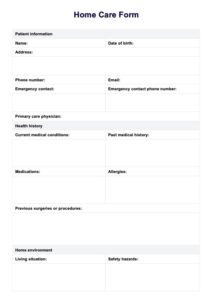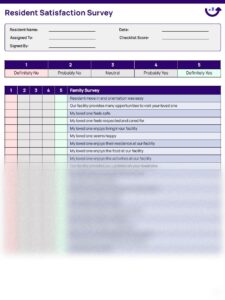Providing a comfortable, safe, and fulfilling environment for residents is at the heart of every great nursing home. But how do you truly know if you’re hitting the mark? The answer often lies in listening to the very people you serve. Understanding their experiences, their joys, and their concerns is not just good practice; it’s essential for continuous improvement and fostering a truly resident-centered community.

This is where a well-crafted nursing home resident satisfaction survey template comes into play. It provides a structured, comprehensive way to gather invaluable feedback directly from your residents, helping you identify what’s working well and pinpoint areas that might need a little more attention. Think of it as your direct line to ensuring the highest quality of life for everyone under your care.
Why a Tailored Survey Template is Indispensable
Imagine being able to regularly tap into the collective experience of your residents, transforming their everyday observations into actionable insights. That’s the power of a dedicated survey template. It moves beyond anecdotal feedback, offering a systematic approach to measure satisfaction across various aspects of daily life within the nursing home. This isn’t just about ticking boxes; it’s about fostering an environment where residents feel heard, valued, and genuinely happy.
A robust survey template helps to shine a light on both the successes and the opportunities for growth within your facility. It allows you to track trends over time, providing clear data that can inform strategic decisions, staff training, and resource allocation. When residents see that their feedback leads to positive changes, it builds a stronger sense of trust and community, reinforcing their belief that they are truly cared for. It empowers them to be active participants in shaping their living environment, which is incredibly beneficial for their overall well-being.
Creating a comprehensive survey template means thinking about every touchpoint a resident has within your facility. From the moment they wake up until they go to sleep, what are their experiences like? Are they feeling engaged? Are their needs being met efficiently and kindly? A good template will cover these nuances, ensuring no stone is left unturned in your quest for excellence.
Key Areas a Template Should Cover
- Quality of Care: This is paramount. Questions should address medical care, personal assistance, responsiveness of staff, and overall compassion.
- Staff Interaction: How friendly, respectful, and helpful are the caregivers, nurses, and administrative staff? Are they approachable?
- Dining Experience: Evaluate food quality, variety, portion sizes, dietary accommodations, and the dining environment itself.
- Activities and Social Engagement: Are there sufficient and engaging activities? Do residents feel included and stimulated?
- Environment and Facilities: Assess cleanliness, comfort, safety, maintenance, and the aesthetics of living spaces and common areas.
- Communication: How well does the nursing home communicate with residents and their families regarding care plans, events, and important updates?
- Overall Well-being: Broader questions about feelings of security, happiness, and sense of community.
By systematically gathering data across these vital areas, a tailored nursing home resident satisfaction survey template becomes an invaluable tool for continuous improvement. It provides concrete evidence that can be used to celebrate successes, address challenges, and ultimately enhance the quality of life for every resident.
Designing and Implementing Your Survey Effectively
Once you understand the ‘why’ behind using a survey, the ‘how’ becomes crucial. Designing your survey isn’t just about listing questions; it’s about crafting an experience that encourages honest and thorough responses. The language should be clear, simple, and empathetic, ensuring that residents, regardless of their cognitive abilities, can understand and respond comfortably. Avoid jargon and complex sentence structures. Remember, the goal is to make it as easy as possible for residents to share their perspectives.
Consider the format of your questions. A mix of quantitative (e.g., scale of 1-5) and qualitative (open-ended comments) questions often yields the richest data. While quantitative data gives you measurable trends, qualitative responses provide the stories and specific examples that explain those numbers, offering deeper insights into resident experiences. For instance, a low rating on “food quality” might be explained by an open-ended comment about a lack of fresh vegetables or repetitive meals.
Ensuring anonymity is paramount. Residents must feel absolutely secure that their honest feedback will not lead to any negative repercussions. Clearly state that responses are confidential and will be used solely for improvement purposes. This trust-building measure is fundamental to obtaining genuine insights. Also, think about accessibility; some residents might need assistance reading or filling out the survey, so having staff or volunteers available to help can be very beneficial.
Here are some best practices for distributing and collecting your surveys:
- Personalized Assistance: Offer one-on-one sessions where a staff member or trained volunteer can read questions and transcribe answers for residents who need assistance.
- Multiple Formats: Provide both paper and, where appropriate, digital options for residents or their family members who prefer online submissions.
- Regular Intervals: Conduct surveys periodically, perhaps quarterly or bi-annually, to track changes and assess the impact of implemented improvements.
- Resident Councils: Share the survey results (anonymously) with resident councils to discuss findings and collaboratively brainstorm solutions.
Finally, the most important step after collecting the data is to act on it. Analyze the results thoroughly, identify recurring themes and areas of concern, and then develop concrete action plans. Communicate these actions back to the residents, demonstrating that their voices truly matter and that their input directly contributes to creating a better home for everyone. This cycle of feedback, action, and communication is what truly elevates a nursing home’s commitment to resident satisfaction.
Implementing a consistent feedback loop through a well-designed survey allows nursing homes to not only meet but often exceed the expectations of their residents and their families. It showcases a dedication to excellence and a proactive approach to care, building a reputation for genuine compassion and continuous improvement.
By regularly seeking and responding to feedback, facilities can cultivate an environment where residents feel a profound sense of belonging and well-being. This proactive stance ensures that the nursing home remains a truly nurturing and responsive place, dedicated to the happiness and comfort of everyone it serves.


